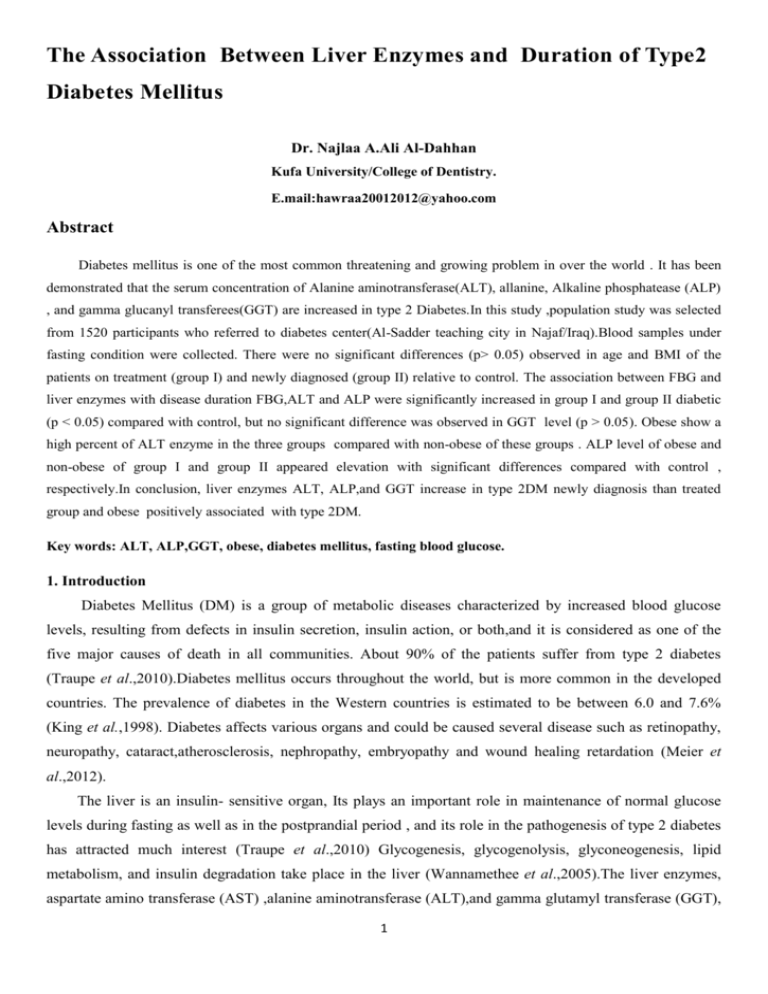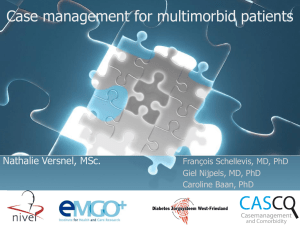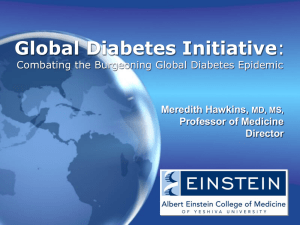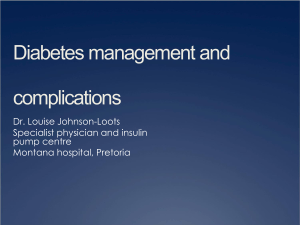The Association Between Liver Enzymes and Duration of Type2
advertisement

The Association Between Liver Enzymes and Duration of Type2 Diabetes Mellitus Dr. Najlaa A.Ali Al-Dahhan Kufa University/College of Dentistry. E.mail:hawraa20012012@yahoo.com Abstract Diabetes mellitus is one of the most common threatening and growing problem in over the world . It has been demonstrated that the serum concentration of Alanine aminotransferase(ALT), allanine, Alkaline phosphatease (ALP) , and gamma glucanyl transferees(GGT) are increased in type 2 Diabetes.In this study ,population study was selected from 1520 participants who referred to diabetes center(Al-Sadder teaching city in Najaf/Iraq).Blood samples under fasting condition were collected. There were no significant differences (p> 0.05) observed in age and BMI of the patients on treatment (group I) and newly diagnosed (group II) relative to control. The association between FBG and liver enzymes with disease duration FBG,ALT and ALP were significantly increased in group I and group II diabetic (p < 0.05) compared with control, but no significant difference was observed in GGT level (p > 0.05). Obese show a high percent of ALT enzyme in the three groups compared with non-obese of these groups . ALP level of obese and non-obese of group I and group II appeared elevation with significant differences compared with control , respectively.In conclusion, liver enzymes ALT, ALP,and GGT increase in type 2DM newly diagnosis than treated group and obese positively associated with type 2DM. Key words: ALT, ALP,GGT, obese, diabetes mellitus, fasting blood glucose. 1. Introduction Diabetes Mellitus (DM) is a group of metabolic diseases characterized by increased blood glucose levels, resulting from defects in insulin secretion, insulin action, or both,and it is considered as one of the five major causes of death in all communities. About 90% of the patients suffer from type 2 diabetes (Traupe et al.,2010).Diabetes mellitus occurs throughout the world, but is more common in the developed countries. The prevalence of diabetes in the Western countries is estimated to be between 6.0 and 7.6% (King et al.,1998). Diabetes affects various organs and could be caused several disease such as retinopathy, neuropathy, cataract,atherosclerosis, nephropathy, embryopathy and wound healing retardation (Meier et al.,2012). The liver is an insulin- sensitive organ, Its plays an important role in maintenance of normal glucose levels during fasting as well as in the postprandial period , and its role in the pathogenesis of type 2 diabetes has attracted much interest (Traupe et al.,2010) Glycogenesis, glycogenolysis, glyconeogenesis, lipid metabolism, and insulin degradation take place in the liver (Wannamethee et al.,2005).The liver enzymes, aspartate amino transferase (AST) ,alanine aminotransferase (ALT),and gamma glutamyl transferase (GGT), 1 are routinely used in evaluation of liver function. ALT is the most specific marker of liver pathology Such as acute hepatic dysfunction and is found primarily in this organ .AST and GGT are also found in other tissues and are therefore less specific markers of liver function (not specific, to be a sensitive indicator of liver damage ) (Lee et al., 2003; Lee et al., 2004). Marchesini et al.(2001) reviled Increased activities of liver enzymes such as AST, ALT and GGT are indicators of hepatocellular injury.Increased activity of these markers is associated with insulin resistance. Liver enzymes are routinely used as the clinical examination indices to assess the liver function. Previous studies suggested that alteration in liver enzymes may be a predisposing and probable risk factor of Type 2 Diabetes Mellitus (T2DM) and complication of long standing T2DM. Diabetes is a challenging public health problem throughout the world and the prevalence has increased at a sharp rate over the past few decades in Iraq. However, only a few investigations have focused considerably the association between liver enzymes and diabetes in the Iraqi population. Studies on liver function abnormalities in type 2 diabetic patients in Iraq are lacking. The purpose of this study is assess liver enzyme concentration as well as glucose in type 2 DM patients and newly diagnosis type 2 DM in Najaf, Iraq.and we examine factors associated with these biochemical changes. 2. Materials & Methods 2.1. Study subject This case-control study was carried out among population who were referred to diabetes center of ALSadder teaching city in Najaf/ Iraq during the 2014-2015.Aboute 1520 individuals were randomly selected as participants with average age over 30 years. All participant underwent clinical examination following questionative interview questionnaire included questions on life style, medical history ,and medical treatment with insulin and oral anti-diabetic agents, body mass index (BMI). were those who, alcoholics, subjects with systemic and other hepatic disease, pregnant women, patients with infectious disease, smoker, patients on drugs (except antidiabetic therapy) patients who were seropostive for hepatitis Band Cor had visible janndice. were excluded from this study. All subjects diagnosed using the American Diabetes association (2008) diagnostic criteria. At the find 300 individuals remain as subjects the subjects were devided into three groups. Group I : 142 (76 female and 66 males) were type 2 DM. Group II: 86 (48 female and 38 males) were type 2 DM newly diagnosis. Group Ш: 72 (54 female and 28 male) were save as control. 2 Blood samples were obtained from an anticubital veinpuncture in the morning after a 12-h over night fast. The blood was centrifuged at 3000 rpm for 15 minutes and serum was stored at-40 c0 analysis. Fasting blood glucose (FBG) was determaind according to the spectrophotometric method described by Barhm and Trinder (1972) using commercial kits obtaind from randox laboratovies Ltd(crumlin,UK). Liver enzymes (alanine amino transferase (ALT), allanine, Alkaline phosphatease (ALP) , and gamma glucanyl transferees(GGT) were estimated by using commercially available kits and methods on fully antomated anglyser machine, Roche, Diagnostic Hitachi 902, Germany. 2.2. Statical analysis All results are presented as mean ± standard diviation (SD).Data are analyzed using spss v.13.AP .Value of p < 0.05 was used as the criterion for a statistically significant difference. 3. Results The biophysical characteris of type 2 DM patients groups and control group are presented in table (1).There were no significant differences (p> 0.05) observed in age of the patients on treatment (group I) and newly diagnosed (group II) relative to control. between BMI of type 2 DM patients groups and those of the control .Males increased significantly (p< 0.05) than males in type 2 DM patients when compared with control. Table 1. Characteristics of T2DM patients and control Characteristic Mean age (years) Male / Female(No) 2 BMI (Kg/m ) Group I Group II Group Ш (Treated T2DM) (Newly diagnosis) (Control) N=142 N=86 N=72 45.60 ± 7.5 41.8 ± 2.06 43.6 ± 4.06 P > 0.05 66 / 76 38 / 48 28 / 54 P < 0.05 23.75 ± 3.41 24.05 ± 1.31 22.43 ± 2.34 P > 0.05 P-value Table (2) and figure (1) depicts the mean values of plasma concentration of FBG,ALP,ALT and GGT and . also shows the degree of association between FBG and liver enzymes with disease duration FBG,ALT and ALP were significantly increased in group I and group II diabetic (p < 0.05) compared with control, but no significant difference was observed in GGT level (p > 0.05). 3 Table 2. Comparison of mean values different parameters T2DM patients and control Parameters (U/L) Mean ± SD P-value Group II Group Ш FBG 11.81 ± 0.81 13.01± 1.31 4.51± 1.2 p< 0.05 ALT 13.24 ± 3.40 19.53 ± 0.51 8.27 ± 1.13 p< 0.05 ALP 230.67 ± 1.30 241.07 ± 1.01 180.78 ± 1.50 p< 0.05 GGT 17.31± 2.04 18.01 ± 2.34 15.04 ± 0.72 p> 0.05 FB G and Liver enzymes (U/L) Group I 241.07 230.67 250 180.78 200 150 100 50 13.24 11.81 19.53 17.31 13.01 8.27 4.51 18.01 15.04 0 Group I (Ttreated T2DM) Group II (Newly diagnosis) FBG (U/L) Group Ш (Control) ALT (U/L) ALP (U/L) GGT (U/L) Figure 1 . Comparison of mean values different parameters T2DM patients As presented in table (4) ,the mean values of liver enzymes (ALT and GGT ) were significantly higher in males than females and with control (p < 0.05) .In contrast, mean value of GGT in females were significantly higher than male compared with control. Table 3. Prevalence of ( ALT, ALP and GGT ) T2DM patients and control ALT (%) ALP (%) GGT (%) Elevated values 26.1 51.4 0 Upper limit of normal 16.2 6.3 4.9 Normal range 57.7 42.3 95.1 Elevated values 24.4 68.6 0 Upper limit of normal 9.3 4.7 4.7 Normal range 66.3 26.7 95.3 Elevated values 0 38.9 0 Upper limit of normal 0 5.6 0 Normal range 100 55.5 100 Type 2 DM on treatment (N=142) Type 2 DM newly diagnosis Control (N=72) 4 Table 4. Liver enzymes mean values of type 2 DM patients based on sex Mean ± SD Parameters Group I Group Ш Group II Male Femal Male Femal Male Femal (n=66) (n=76) (n=38) (n=48) (n=28) (n=44) ALT 14.68 ± 1.04 11.9± 0.91 22.5± 1.01 16.35± 1.33 11.45± 1.21 9.93± 1.02 ALP 215.6± 2.54 245.9± 2.13 226.5± 0.45 257.32± 1.34 179.57± 3.34 182.21± 2.12 GGT 23.4± 0.78 20.5± 0.26 29.4± 3.02 21.05± 1.08 22.74± 4.02 19.07± 2.01 Figure (2 A) shows high percentage of ALT, in obese of group II patients (20.5) and group I (13.4 ) and control (12.8) compared with non-obese of these groups with no significant change (p > 0.05) .The extent of ALT elevation was significantly higher in obese of group II (20.5 ) than obese of group II and control. ALP level of obese and non-obese of group I (238.6, 227.4 )% and group II (239.5, 242.1) appeared elevation with significant differences (p< 0.05) compared with control (181.5,179.4), respectively ,figure(2B).Figure ( 2 C) appeared no significant change between obese and non obese of type 2 diabetic patients in group I and II with regard to GGT. 5 ALT (U/L) 30 20.5 20 13.4 17.2 12.8 11.2 9.3 10 0 GroupI(TtreatedT2DM) GroupII(Newlydiagnosis) GroupШ(Control) Obese Non-obese A. 239.5 238.6 227.4 ALP (U/L) 300 242.1 181.5 179.4 200 100 0 GroupI(TtreatedT2DM) GroupII(Newlydiagnosis) GroupШ(Control) Obese Non-obese GGT (U/L) B. 25 20 15 10 5 0 18.4 17.9 20.5 18.3 16.7 12.4 GroupI(TtreatedT2DM) GroupII(Newlydiagnosis) GroupШ(Control) Obese Non-obese C. Figure 2. A: ALT, B: ALP and C: GGT Mean values of liver enzymes concentration based on Body Mass Index (BMI) 6 4. Discussion Elevated hepatic enzymes might be helpful to identify persons who are likely to have insulin resistance and who are at particularly high risk to diabetes. The present study has also supported that NAFLD plays an important role in the pathogenesis of diabetes( Fei et al.,2012 ). Inflammation has also been recognized as a manifestation of oxidative stress, and all pathways that generate mediators of inflammation, such as adhesion molecules and interleukins, are induced by oxidative stress. Changes in inflammation that occur through oxidative stress are assumed to be a common step in the pathogenesis of type 2 diabetes (Doi et al.,2005). The findings of the present study are in agreement with that of Andre et al.(2005) and Odewabi et al.(2013). perry et al.(1998) recognized NAFID as a complication of diabetes and affects both male and female. and suggestd NAFID or NASH as the probable reason for elevated liver enzymes. Choudhary et al.(2014) and Belay et al.(2014) showed that serum AST,ALT,ALP,GGT significantly increase in type 2DM patients when compared to type1 DM subjects. No association was observed in values of serum total bilirubin, total protein and albumin of type 2 DM subject. Fei et al.(2012) identified that serum ALT and GGT were closely related to the pre‐diabetes and T2DM in the Shanghai population in China even after adjustment for a broad spectrum of type 2 diabetes risk factors. These two liver enzymes were also independently associated with insulin resistance index. ALP was independently associated with obesity and central adiposity, whereas only high serum triglycerides were associated with raised levels of each of the four enzymes .Similar findings were reported in a study by Iqbal and Alam (2013) in which the mean values of ALT, AST and GGT liver enzymes were significantly higher in type 2 diabetic patients than in controls (P<0.001). In contrast, values of total protein and albumin concentrations were significantly lower in diabetes than in controls at, a 99.0% significance level. Cho et al.,(2007) found increased activity of liver enzymes, notably ALT, was associated with a twofold increase in the risk of type 2 diabetes independently of conventional risk factors and serve as a useful marker to identify individuals at high risk of type 2 diabetes in Asian populations. potential risk factors of DM including age, family history, BMI, alcohol intake, and insulin resistance in both sexes. Cho et al.,(2007) showed that individuals in the top ALT quartile have the highest levels of high-sensitivity C-reactive protein, which is also an independent predictor for type 2 diabetes . Ahn et al.(2014) founded that elevated serum ALT concentrations in both sexes and GGT only in females were independently associated with type 2 diabetes. The associations between these enzymes and incidence of type 2 diabetes were independent of insulin resistance, inflammation and/or oxidative stress markers. Odewabi et al.(2013) observed that ALT and FPG exhibited significant positive correlation with disease duration in diabetic subjects but such correlation was not seen in the control subjects. Increasing fatty acids 7 have direct toxic effect on hepatocytes that it can cause to release ALT enzyme of the liver cells (Neuschwander-Tetri and Caldwell,2003).Saligram et al.(2015) suggested there is a high incidence of abnormal ALT levels, which is associated with features of the metabolic syndrome (obesity and lipid abnormalities), but not glycemic control and demonstrating higher serum triglycerides and lower HDL cholesterol in the raised ALT group. Nannipieri et al.(2005) implecated that Although mild elevations in liver enzymes are associated with features of the metabolic syndrome, only raised GGT is an independent predictor of deterioration of glucose tolerance to IGT or diabetes. GGT was the enzyme clustering with the largest number of features of metabolic syndrome (including male sex, dyslipidemia, hyperinsulinemia, and IGT or type 2 diabetes). and GGT was the sole marker for the full metabolic syndrome after adjusting for anthropometric variables and alcohol consumption. GGT apart from being a marker of hepatic steatosis is strongly associated with visceral fat, obesity, cholelithiasis and oxidative stress. The GGT levels in patients on treatment show no significant difference with that of the control subjects. This finding is similar to the observation of Nakanishi et al.(2004). Oxidative stress is suggested to be a potential contributor to the development of DM and the associated complications during which free radicals are generated. Free radical production leads to depletion of glutathione, induces the expression of GGT in liver (Moriya et al.,1994) and subsequently elevates serum activity of GGT (Whitfield, 2001). Unfortunately, associated obesity is a frequently occurring confounding variable. Fat is stored in the form of triglyceride and may be a manifestation of increased fat transport to the liver, enhanced hepatic fat synthesis, and decreased oxidation or removal of fat from the liver. Engelmann et al.(2014) found Absolute alanine amino transferase levels are significantly higher in obese than in overweight children. Even obese children with normal liver enzymes show signs of fatty liver disease as demonstrated by liver enzymes at the upper limit of normal, and concluded, that fatty liver disease appears in very young children with obesity and that the degree of obesity contributes to the extent of fatty liver disease in this age group. A study in obese Turkish school children demonstrated a significant elevation of ALT and AST (Arslan et al.2005). But these children and adolescents were older than those in our study. Other researchers have reported an association between elevated ALT activity and fatty liver (Nannipieri et al.,2005; Marchesini et al.,2005) in obesity, insulin resistance, and type 2 diabetes . Another study has shown that ALT activity even within the normal range correlates with increasing hepatic fat infiltration (Tiikkainen et al,2003). In contrast, elevated AST and GGT activities are not related to hepatic or whole-body insulin sensitivity (Vozarova et al.,2002). 8 REFERENCE Ahn H.R., Shin M.H., Nam H.S., Park K.S., Lee Y.H., Jeong S.K., Choi J.C. and Kweon S.S.(2014).The association between liver enzymes and risk of type 2 diabetes: the Namwon study .J. Diabetology and Metabolic Syndrome, 6:14. Andre P., Balkau B. and Born C.(2005).Hepatic markers and development of type 2 diabetes in middle aged men and women: A three years follow- up study. The D.E.S.I.R. study. Diabetes Metab.,31: 542-550. Arslan N., Buyukgebiz B., Ozturk Y.and Cakmakci H.(2005).Fatty liver in obese children:prevalence and correlation with anthropometric measurements and hyperlipidemia. Turk J. Pediatr,47(1):23–7. Barham D.and Trinder P.( 1972).An improved colour reagent for the determination of blood glucose by the oxidase system. Analyst, 97: 142-145. Belay Z., Daniel S., Tedla K. and Gnanasekaran N.(2014). Impairment of Liver Function Tests and Lipid Profiles in Type 2 Diabetic Patients Treated at the Diabetic Center in Tikur Anbessa Specialized Teaching Hospital (Tasth), Addis Ababa, Ethiopia.J. Diabetes Metab, 5:11. Cho N.H., Jang H.C., Choi S.H., Lee H.K., Lim S., Kim H.R. and Chan J.C.N.(2007).Abnormal Liver Function Test Predicts Type 2 Diabetes. Diabetes Care, 30(10) :2566-2568. Choudhary M., Jinger S.K., Yogita, Gahlot G.,and Saxena A.R. (2014). Comparative study of liver function test in type 1 and type 2 diabetes mellitus. Indian j. Sci.Res.,5(2):143-147. Doi Y., Kiyohara Y., Kubo M., Ninomiya T., Wakugawa Y., Yonemoto K. and Iwase M.(2005). Elevated C-reactive protein is a predictor of the development of diabetes in a general Japanese population: the Hisayama Study. Diabetes Care, 28:2497–2500. Engelmann G., Hoffmann G.F., Henn J.G. and Teufe U.(2014).Alanine Aminotransferase Elevation in Obese Infants and Children:A Marker of Early Onset Non Alcoholic Fatty Liver Disease.Hepat Mon. ,14(4): 14112. Fei G., Min P.J., Hong H.X., Chen F.Q., Juan H.J., Ling T.J., Lin G.H., Jian P.Z., Hua Y.Y., Zhen S.W. and Ping J.W.(2012). Liver Enzymes Concentrations Are Closely Related to Prediabetes: Findings of the Shanghai Diabetes Study II (SHDS II).Biomed Environ Sci, 25(1): 30‐37. Iqbal S.and Alam A. (2013) .Renal disease in diabetes mellitus: Recent studies and potential therapies. J Diabetes Metab s9-006. King H., Aubert R.E. and Herman W.H.(1998).Global burden of diabetes,1995-2025:Prevalence, numerical estimates and projections. Diabetes Care, 21: 1414-1431. Lee D.H., Ha M.H.,Kim J.H., Christiani D.C.,Gross M.D., Steffes M., Blomhoff R. and Jacobs D.R.(2003). Jr:Gamma-glutamyltransferase and diabetes-a 4 year follow-up study. Diabetologia, 46:359– 364. 9 Lee D.H.,Silventoinen K.,Jacobs D.R,Jousilahti P.andTuomileto J.(2004).Gamma-Glutamyltransferase, obesity, and the risk of type 2 diabetes: observational cohort study among 20,158 middle-aged men and women. J. Clin Endocrinol Metab 2004, 89:5410–5414. Marchesini G.,Avagnina, S., Barantani G.R.,Morpurgo,P.S.,Tomasi,F.and E.G., Ciccarone, A.M., Corica, F.,Dall’Aglio, E.,Dalle, Vitacolonna,E.(2005). Aminotransferase and gamma glutamyl trans peptidase levels in obesity are associated with insulin resistance and the metabolic syndrome. J. Endocrinol Invest 28:333–339. Marchesini, G., Brizi, M., Bianchi, G., Tomassetti ,S., Bugianesi, E., Lenzi, M., McCullough, A.J., Natale, S., Forlani, G.,and Melchionda, N.(2001). Nonalcoholic fatty liver disease: a feature of the metabolic syndrome. Diabetes 50:1844–1850. Meier P.,Hemingway H., Lansky A.J., Knapp G.and Pitt B.(2012) The impact of the coronary collateral circulation on mortality: a meta-analysis. Eur Heart J 33: 614-621. Moriya S., Nagata S., Yokoyama H., Kato S.and Horie Y.(1994).Expression of gamma-glutamyl transpeptidase mRNA after depletion of glutathione in rat liver. Alcohol Alcohol Suppl., 29(1): 107-111. Nakanishi N., Suzuki K. and Tatara K.(2004).Serum gamma-glutamyl transterase and risk of metabolic syndrome and type 2 diabetes in middle-aged Japanese men. Diabetes Care, 27: 1427-1432. Nannipieri M., Baldi S., Posadas R., Ferrannini E., Gonzales C.,Williams K., Haffner S.M., and Stern M.P.(2005). Liver Enzymes, the Metabolic Syndrome,and Incident Diabetes.Diabetes Care,28(7):17571762. Neuschwander-Tetri, B.A., and Caldwell,S.(2003). Nonalcoholic steatohepatitis: summary of AASLD single topic conference. Hepatology 37:1202–1219. Odewabi A.O., Akinola E.G. ,Ogundahunsi O.A. , Oyegunle V.A. , Amballi A.A., Raimi T.H. and Adeniyi F.A. (2013). Liver Enzymes and its Correlates in Treated and Newly Diagnosed Type 2 Diabetes Mellitus Patients in Osogbo, South West, Nigeria. Asian J. Med. Sci., 5(5): 108-112. Perry I.J., Wannamethee S.G. and Shaper A.G.( 1998). Pros pectivestudy of serum gamma-glutamyl transferase and risk of NIDDM. Diabetes Care, 21: 732-737. Saligram S.,Williams E.J.and Masding M.G.(2015).Raised liver enzymes in newly diagnosed Type 2 diabetes are associated with weight and lipids,but not glycaemic control. Indian Journal of Endocrinology and Metabolism (16 ):1012-1014. Tiikkainen M., Bergholm R., Vehkavaara S., Rissanen A., Hakkinen A.M., Tamminen M., Teramo K. and Yki-Jarvinen H.(2003) Effects of identical weight loss on body composition and features of insulin resistance in obese women with high and low liver fat content. Diabetes 52:701–707. Traupe T., Gloekler S., de Marchi S.F., Werner G.S.and Seiler C. (2010). Assessment of the human coronary collateral circulation .Circulation 122: 1210-1220. 10 Vozarova B., Stefan, N., Lindsay, R.S., Saremi, A., Pratley, R.E., Bogardus, C., and Tataranni, P.A.(2002). High alanine minotransferase is associated with decreased hepatic insulin sensitivity and predicts the evelopment of type 2 diabetes. Diabetes 51:1889–1895. Wannamethee S.G.,Lennon,L.and Shaper A.G.(2005). Hepatic enzymes, the metabolic syndrome, and the risk of type 2 diabetes in older men. Diabetes Care, 28, 2913‐8. Whitfield J.B.( 2001). Gamma glutamyl transferase. Crit. Rev. Clin. Lab. Sci., 38: 263-355. 11








